Movie nights at home have evolved beyond simply streaming a film and munching on popcorn. With the right technology, you can transform your living room into an immersive cinema experience that rivals the real thing. Smart home technology can elevate your movie nights by creating the perfect atmosphere, enhancing sound quality, and adding convenient features that make the entire experience more enjoyable.
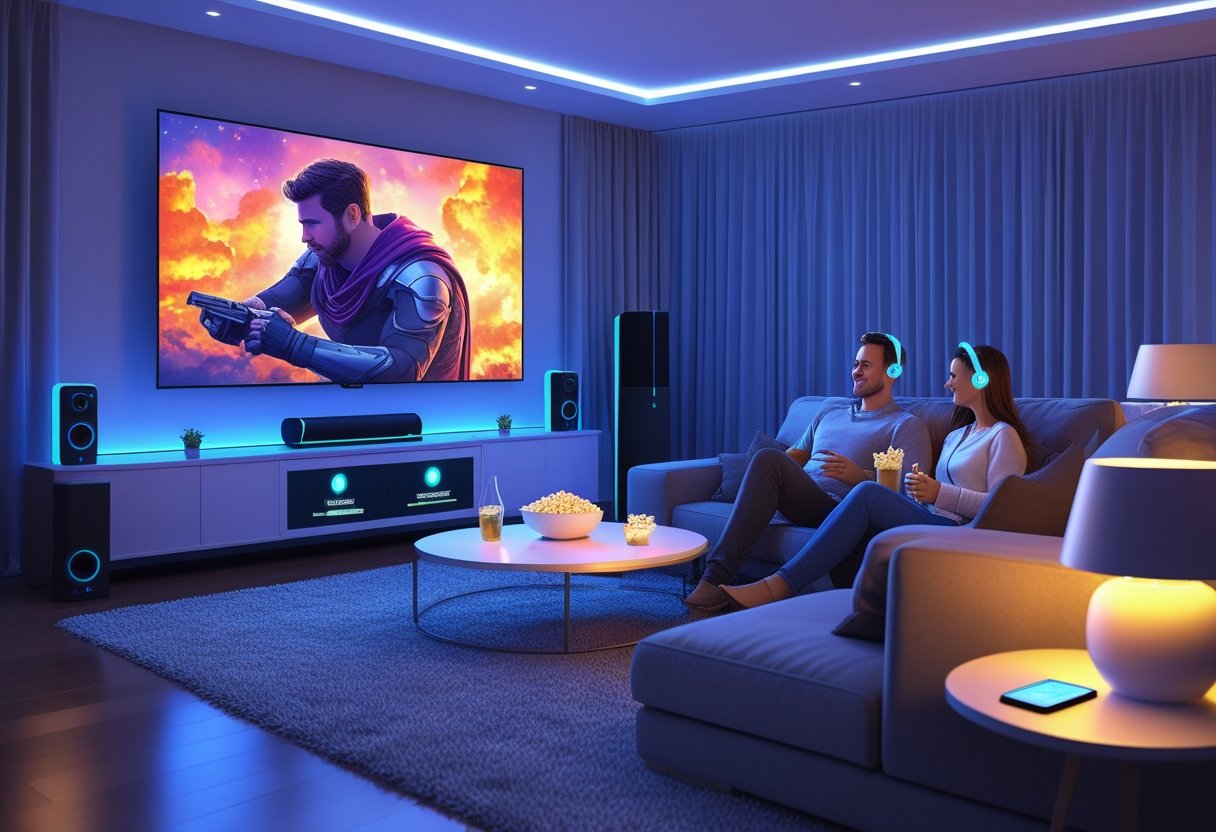
I’ve discovered that creating memorable movie nights doesn’t require a complete home theater renovation. By strategically incorporating smart lighting that dims to total darkness and setting up a high-performance audio system, you can significantly enhance the viewing experience. Smart tech allows you to control everything from your phone, creating seamless transitions from pre-movie socializing to the main feature.
Making movie night special is about creating a complete sensory experience. I recommend focusing on creating a cozy environment with comfortable seating and smart lighting that adapts throughout the evening. With the right combination of technology and ambiance, your home movie nights can become the highlight of everyone’s week.
Key Takeaways
- Smart lighting and audio systems create an immersive theater-like atmosphere that transforms ordinary movie nights into exceptional experiences.
- Automating your entertainment space with smart home technology allows for seamless control of lighting, sound, and climate from a single device.
- Personalizing the viewing environment with smart tech accommodates different preferences and enhances comfort for all guests.
Setting the Scene with Smart Lighting
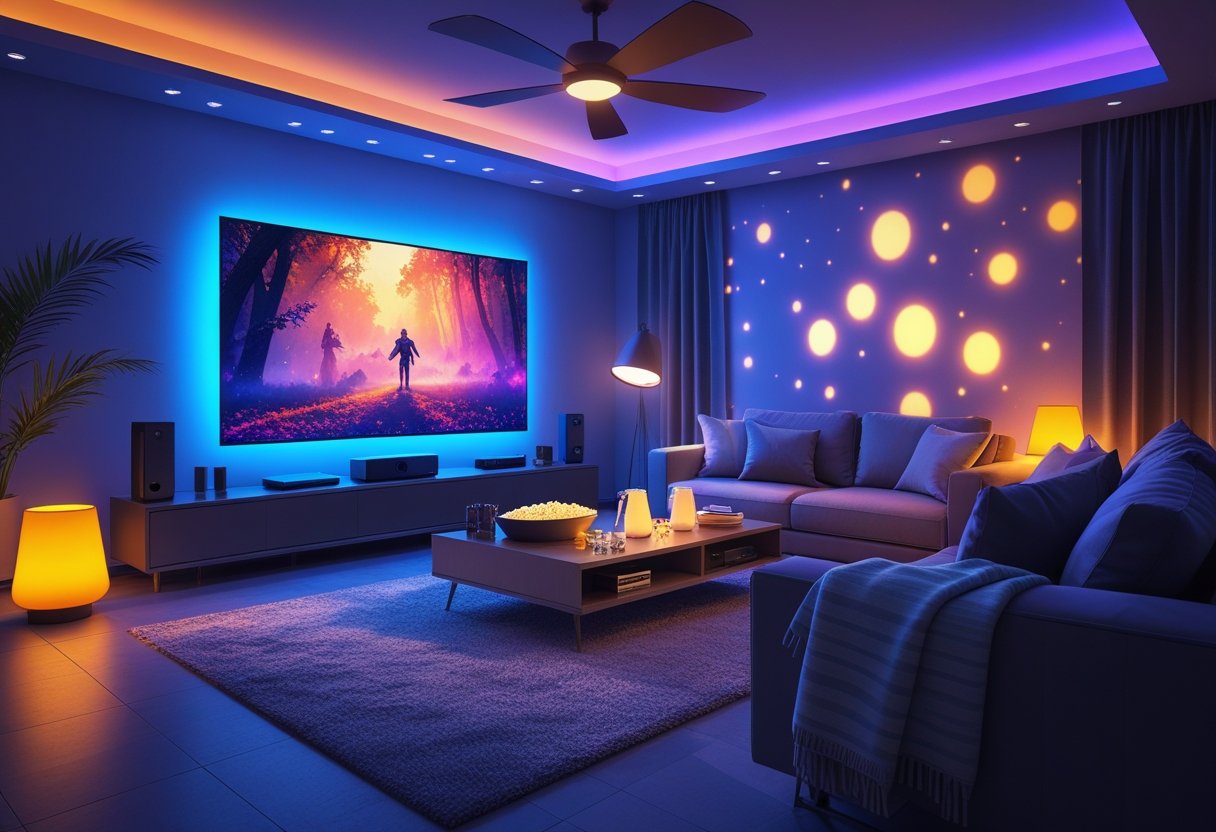
Smart lighting transforms an ordinary movie night into an immersive experience by enhancing the atmosphere and complementing what’s happening on screen. The right lighting setup can eliminate distractions, create the perfect ambiance, and even sync with your movie’s content for a theater-quality experience at home.
Creating Ambiance with Custom Lighting Scenes
Movie genres each call for different lighting moods. For horror films, I recommend using deep reds or blues at low intensity to amplify tension. Action movies pop with subtle amber tones, while romantic comedies benefit from warm whites or soft pinks.
Most smart lighting systems like Philips Hue and LIFX allow you to set the mood with pre-programmed scenes for different viewing experiences. I’ve created custom scenes named “Thriller Night,” “Romance,” and “Sci-Fi Adventure” on my system.
Setting up dedicated lighting scenes is straightforward:
- Create scenes through your smart lighting app
- Name them intuitively for quick access
- Adjust brightness levels (usually 10-30% is ideal for movies)
- Save favorites for one-touch activation
Automating Lights for Seamless Transitions
Automation eliminates the disruption of manually adjusting lights. I’ve programmed my lights to dim gradually when I start my streaming app, mimicking the theater experience where lights fade before the feature presentation.
Smart home systems can trigger lighting scenes automatically when activating your “Movie Night” routine. When integrated with motion sensors, lights can briefly brighten when someone leaves for snacks.
Consider these automation triggers:
- Voice commands (“Movie time” to your assistant)
- Time-based (lights dim at your regular movie time)
- TV power status (lights adjust when TV turns on)
- Streaming app launch (triggers cinema mode)
Syncing Lights with On-Screen Action
The most immersive lighting experience comes from systems that synchronize with on-screen action. Philips Hue Play HDMI Sync Box and Govee Immersion TV backlights analyze video content and adjust lighting colors in real-time.
When explosions happen on screen, my room flashes orange. During underwater scenes, everything bathes in blue. This effect creates a viewing experience that extends beyond the TV’s borders.
Setup requires specific hardware and consideration:
- HDMI sync boxes for complete integration
- LED light strips mounted behind the TV
- Smart bulbs positioned strategically around the room
- Processing speed (faster systems reduce lag between screen and lights)
The sync effect is particularly impressive with action sequences and visually dynamic content like animated films. I recommend testing different settings to find the right balance between immersion and distraction.
Immersive Audio Enhancements
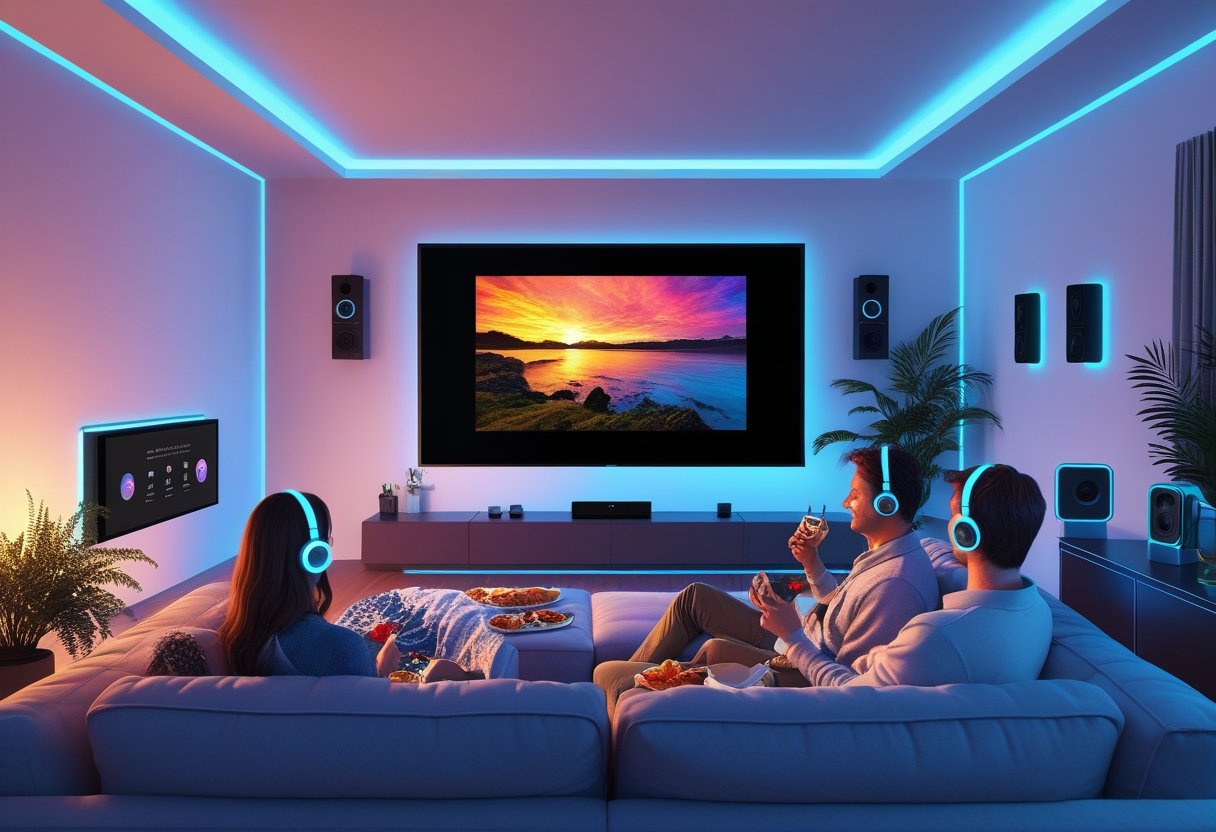
Audio quality can transform an ordinary movie night into a cinematic experience. The right sound setup creates dimensional audio that places you in the center of the action.
Choosing the Right Smart Speakers or Soundbars
When selecting audio equipment, I recommend focusing on compatibility with your existing smart home ecosystem. A quality soundbar like the Sonos Arc integrates seamlessly with voice assistants while delivering Dolby Atmos sound.
For larger rooms, consider a complete surround sound system with dedicated rear speakers. These systems create true immersive experiences by projecting sound from multiple directions.
Smart speakers with multi-room capabilities allow you to extend movie audio throughout your home. This is particularly useful for parties or when you need to step away briefly without missing dialogue.
Pay attention to audio processing features. Look for systems that offer night mode (reduces loud effects while keeping dialogue clear) and dialogue enhancement for better speech clarity during quiet scenes.
Setting Up Surround Sound with Voice Control
Voice control transforms how you manage your audio experience. I can adjust volume, switch sound modes, or even pause playback without searching for a remote.
Start by placing speakers according to manufacturer guidelines—typically front speakers at ear level and surrounds slightly above ear height. Most smart systems include auto-calibration features that optimize sound based on your room’s acoustics.
Create custom voice commands for specific scenarios: “Movie night mode” could dim the lights and activate surround sound simultaneously.
Smart systems allow personalized audio profiles for different users or content types. I’ve created separate profiles for action movies (bass-heavy) versus dialogue-driven dramas.
For the best experience, eliminate background noise when watching. Many smart home systems can automatically turn off noisy appliances when movie mode is activated.
Ultimate Comfort Through Smart Climate Control
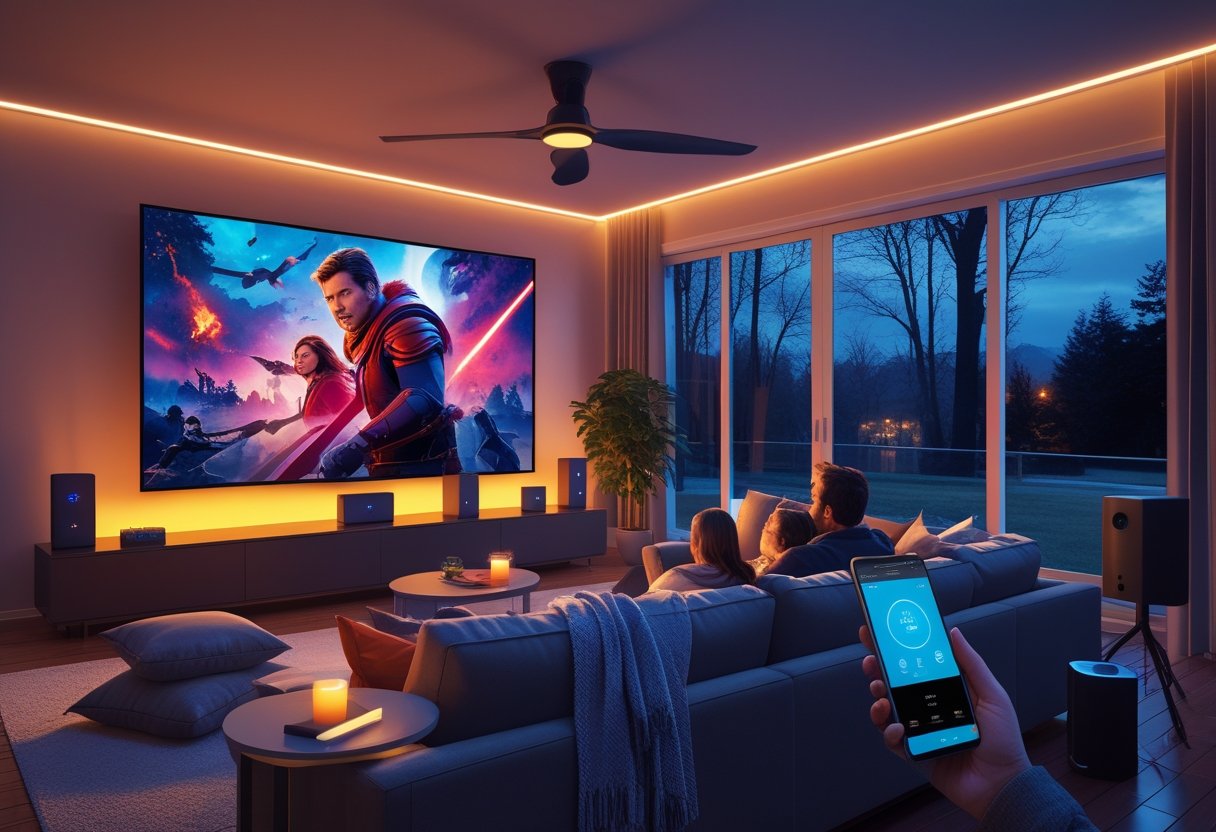
Smart climate systems transform the movie-watching experience by maintaining ideal comfort levels throughout your viewing session. Modern smart home technology now allows precise control of your environment with minimal effort while maximizing enjoyment.
Optimizing Temperature for Cozy Movie Nights
I’ve found that setting the perfect temperature is crucial for an immersive movie experience. Smart thermostats like those integrated with Control4 Smart Homes can be programmed to automatically adjust when movie night begins.
A temperature between 68-72°F (20-22°C) typically works best for most viewers while under blankets. Consider creating a dedicated “Movie Night” scene in your smart home app that triggers the perfect temperature 15 minutes before showtime.
What makes this truly convenient is the ability to adjust without leaving your seat. If you get too warm during the film, a simple voice command or tap on your phone can lower the temperature without pausing the action.
Smart vents in individual rooms can further enhance this experience by directing airflow precisely where needed.
Integrating Air Quality Sensors
Beyond temperature, air quality significantly impacts comfort during extended viewing sessions. Smart air purifiers with built-in sensors can monitor and adjust air quality in real-time while you watch.
I recommend devices that track multiple air quality factors:
- Particulate matter (PM2.5)
- VOC levels
- Humidity (40-60% is ideal)
- CO2 concentration
These systems can work silently in the background, automatically increasing filtration during movie nights when multiple people gather in a closed space. This is especially valuable for transforming your living room into a cinema oasis.
For those with allergies, scheduling a pre-movie air purification cycle ensures the cleanest possible environment before guests arrive. Most smart systems can be set to reach optimal air quality precisely when your movie is scheduled to begin.
Interactive Movie Night Experiences
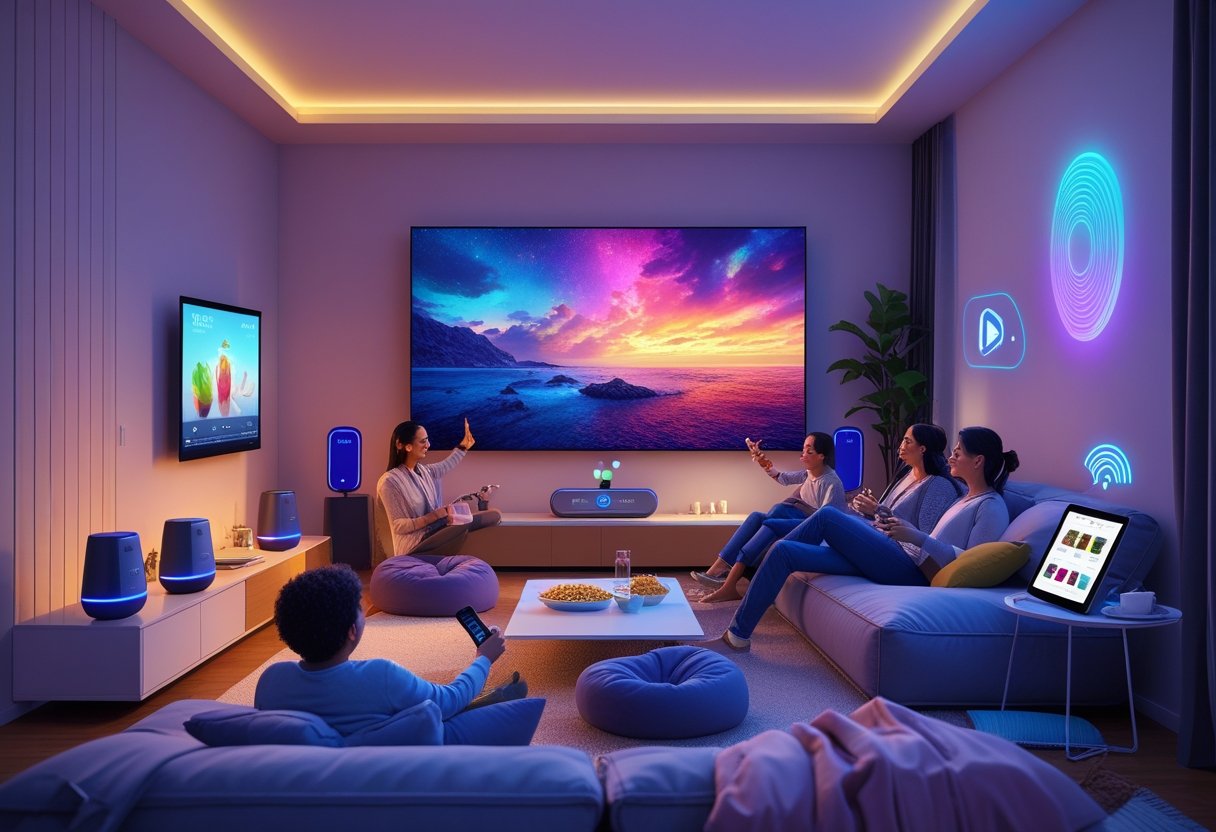
Technology can transform passive viewing into engaging activities that bring everyone together. Smart devices now enable real-time interaction during movies, creating memorable experiences for family and friends.
Voice-Activated Movie Selections
I’ve found that voice assistants like Alexa, Google Assistant, and Siri make browsing and selecting movies effortless. Instead of fumbling with remotes, I simply say “Play the latest Marvel movie” or “Find family comedies from the 90s” to instantly access content.
Most streaming services now offer voice compatibility, allowing me to pause, rewind, or adjust volume hands-free. This is particularly useful when I’m settled with snacks and don’t want to disrupt the viewing experience.
For homes with multiple smart TVs, I can specify which room should play what content. “Play Frozen in the kids’ room and The Godfather in the living room” ensures everyone enjoys their preferred entertainment simultaneously.
Real-Time Trivia and Polls via Smart Devices
Movie nights become more engaging with interactive games like movie bingo or trivia played through tablets or smartphones. I use apps like Kahoot or MoviePoll to create custom quizzes about film facts or character details.
Second-screen experiences enhance viewing by providing real-time information about actors, filming locations, and behind-the-scenes details as scenes unfold. Apps like IMDB or RunPee sync with what I’m watching to deliver relevant content.
Smart home systems can facilitate audience participation through polls. I can create quick votes during movie night:
- “Which character will survive until the end?”
- “What should we watch next?”
- “Rate this scene from 1-10”
These interactive elements transform passive watching into an engaging social experience that keeps everyone involved throughout the film.
Smart Snacks and Refreshment Solutions
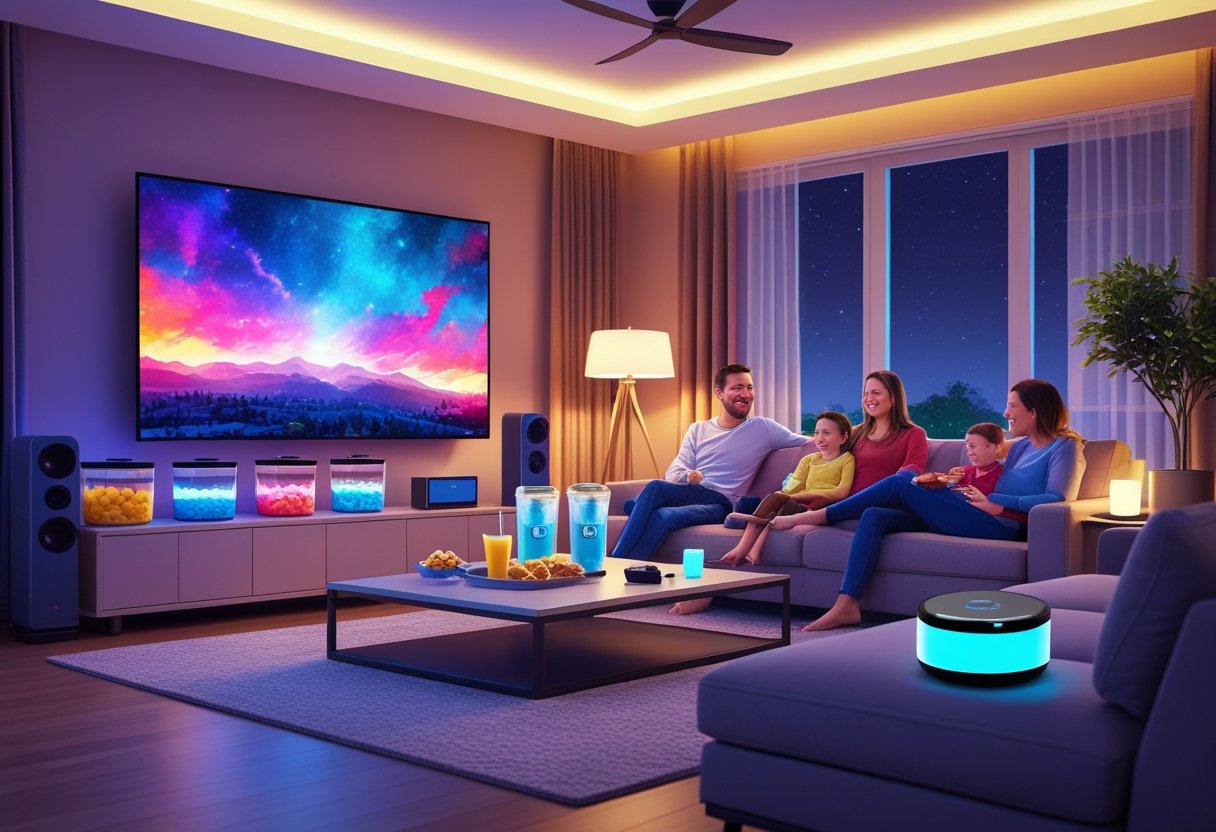
A movie night isn’t complete without delicious snacks and beverages at arm’s reach. I’ve discovered that integrating smart technology into refreshment preparation can elevate the entire experience while reducing trips to the kitchen during crucial movie scenes.
Automated Snack Makers and Coffee Machines
Wi-Fi-enabled popcorn makers now allow me to start popping kernels from my phone before the movie begins. I can control temperature and popping time through dedicated apps, ensuring perfect popcorn every time without leaving the couch.
Smart coffee machines with scheduling features brew fresh coffee right when the credits roll for those late-night movies. I particularly love models that remember my preferred strength and temperature settings for different movie genres – stronger coffee for thrillers, milder blends for comedies.
Voice-activated snack dispensers have become a game-changer for my movie nights. With a simple command, I can get precisely measured portions of candies, nuts, or chocolates without pausing the film or creating a mess.
Smart Refrigerators for Movie Treats
Modern smart refrigerators with digital displays let me check what refreshments I have available without opening the door and disrupting the movie ambiance. My refrigerator sends notifications when movie night essentials like soda or ice cream are running low.
Some advanced models include customizable compartments with temperature controls perfect for keeping chocolates just right or ensuring drinks stay at the perfect chill level throughout the film.
Quick-access drawers in smart refrigerators can be designated specifically for movie treats, making them easily accessible without searching. I’ve set mine to slightly cooler temperatures for candies and slightly warmer settings for ice cream to achieve the perfect consistency.
Built-in beverage stations in newer models dispense filtered water and ice without opening the main compartment, minimizing disruptions during pivotal movie moments.
Personalized Viewing for Every Guest
Smart home technology now enables tailored movie experiences that adapt to individual preferences and needs. These personalized options create more inclusive entertainment spaces where everyone can enjoy content their way.
Custom Profiles and Viewing Preferences
Creating individual user profiles within your smart home entertainment system lets family members and guests access personalized experiences with minimal effort. Many streaming platforms already support multiple user profiles, but integration with your smart home takes this further.
Voice-activated systems can identify different users and automatically load their preferred settings. “Hey Google, it’s movie night for Emma” might dim lights to 30%, select the action genre recommendations, and set subtitles to appear.
Temperature preferences can be stored too. I’ve found that programming your smart thermostat to adjust based on who’s watching creates surprising comfort improvements. Some guests prefer cooler temperatures during intense action sequences, while others enjoy warmth during lengthy dramas.
Movie night boxes with personalized snacks, drinks, and treats for each viewer add a thoughtful touch that complements the technological customization.
Adjustable Accessibility Features
Modern smart home theaters can address various accessibility needs through simple automation. Text-to-speech functionality, customizable subtitle sizes and colors, and audio descriptions can be enabled with voice commands or automatically based on user profiles.
Smart lighting plays a crucial role in accessibility. I recommend setting up pathways with motion-activated lighting for safe navigation during movies. Automated bias lighting behind screens reduces eye strain during extended viewing sessions.
For those with hearing impairments, many surround sound systems now offer dialogue enhancement features that can be individually controlled through companion apps. These can be adjusted for specific viewers without changing everyone’s experience.
Smart remotes with tactile buttons and voice control options make navigation simpler for guests with limited mobility or vision impairments. Some systems enable control through smartphones, allowing everyone to adjust their experience independently.
Creating Lasting Memories with Smart Home Automation
Smart home technology doesn’t just enhance the movie viewing experience—it can also help preserve those special moments. With the right automation setup, I can capture and share memories of movie nights with friends and family.
Scheduled Photo Captures and Video Highlights
I’ve found that setting up automated photo captures during movie nights creates effortless memories without disrupting the experience. Using smart home automation, I can program my smart cameras to take photos at specific intervals or trigger them when everyone laughs or reacts.
Some smart systems can even detect when people are smiling or gathered together, capturing natural moments rather than posed photos. These candid shots often become the most cherished memories.
For extra special movie marathons, I set my system to compile these images into a time-lapse video showing the progression of the night. This works especially well for themed movie nights or seasonal film festivals.
The best part? These photos and videos can be automatically tagged and organized in my cloud storage, making them easy to find years later.
Sharing Moments Instantly via Smart Displays
Smart displays transform how I share movie night memories with both present guests and absent friends. During the event, I can set up my smart displays to showcase photos from previous movie nights as pre-show entertainment.
After capturing new memories, I can instantly display them on screens throughout my home. My guests love seeing their reactions projected onto secondary displays while we’re still enjoying the evening.
For friends who couldn’t attend, I’ve configured my smart home system to automatically share highlight photos to our shared album or group chat. This creates a sense of inclusion even for those who couldn’t be physically present.
Some of my favorite smart displays allow for voice-activated sharing, so I can simply say “share that last photo with Mom” without interrupting the movie experience. This immediate sharing creates a wider sense of community around our movie traditions.
Frequently Asked Questions
Smart home technology has revolutionized how we experience entertainment at home. The right devices, proper configuration, and thoughtful integration can transform an ordinary movie night into an extraordinary cinematic experience.
What are the best smart home devices to enhance a home cinema experience?
For a truly elevated movie night, I recommend starting with a smart TV or projector that supports 4K resolution and HDR content. These devices provide stunning visual quality that rivals commercial theaters.
Smart soundbars or surround sound systems from brands like Sonos or Bose offer exceptional audio that can be controlled via smartphone apps. Some systems automatically adjust sound profiles based on what you’re watching.
Smart plugs can also enhance your setup by allowing you to control non-smart devices like older speakers or ambient lighting with voice commands or automation routines.
How can smart lighting contribute to a more immersive movie night atmosphere?
Smart lighting creates the perfect ambiance for movie viewing. I find that color-changing bulbs like Philips Hue or LIFX can be programmed to complement what’s happening on screen, enhancing emotional impact.
You can create a cozy environment by adjusting lighting to set the right mood. Dimming capabilities allow you to reduce brightness without plunging the room into complete darkness.
Automated light scenes can be triggered when you start a movie, instantly transforming your living room into a theater-like setting with subtle wall washing or backlighting that reduces eye strain.
In what ways can voice-activated assistants be used to streamline movie nights at home?
Voice assistants like Alexa, Google Assistant, or Siri allow hands-free control of your entertainment system. I can simply say “Movie night mode” to dim lights, turn on the TV, and start streaming services.
These assistants can help settle debates by providing instant information about actors, directors, or movie trivia without interrupting the viewing experience. They’re also perfect for ordering food delivery without pausing the film.
Creating custom routines enables sequential automation—your assistant can lower smart blinds, adjust thermostat settings, and even silence notifications on connected devices with a single command.
What are the top tips for using smart home technology to simulate a theater-quality sound system?
Position smart speakers strategically around your viewing area to create true surround sound. Many systems now offer room calibration features that analyze your space’s acoustics for optimal performance.
I recommend using a dedicated subwoofer that can be individually controlled through your smart home app to adjust bass levels based on the type of movie you’re watching or time of day.
Creating the ultimate home theater experience involves careful sound system selection that complements your space. Smart equalizers can automatically adjust audio settings based on content type.
Which smart home features can help manage comfort and convenience during a home movie night?
Smart thermostats ensure optimal viewing comfort by maintaining perfect temperature throughout movie night. Some can even adjust settings based on how many people are in the room.
Automated smart blinds or curtains can eliminate screen glare at the touch of a button or on a schedule aligned with sunset times. This prevents mid-movie disruptions to adjust window coverings.
Doorbell cameras with silent modes route notifications to your phone instead of interrupting the film, allowing you to discreetly check who’s at the door without missing key scenes.
How can one incorporate smart home gadgets for interactive activities during a family movie night?
Interactive movie experiences can be enhanced with smart lighting that reacts to on-screen action. Some systems integrate with specific films to create synchronized light shows that extend the movie beyond the screen.
Smart projectors can transform walls into interactive surfaces for movie-themed games before the main feature. These pre-show activities build excitement while waiting for everyone to gather.
Voice-controlled trivia games related to the night’s feature film can be played through smart speakers. I’ve found this especially engaging for family movie nights as it adds an educational element to entertainment.
